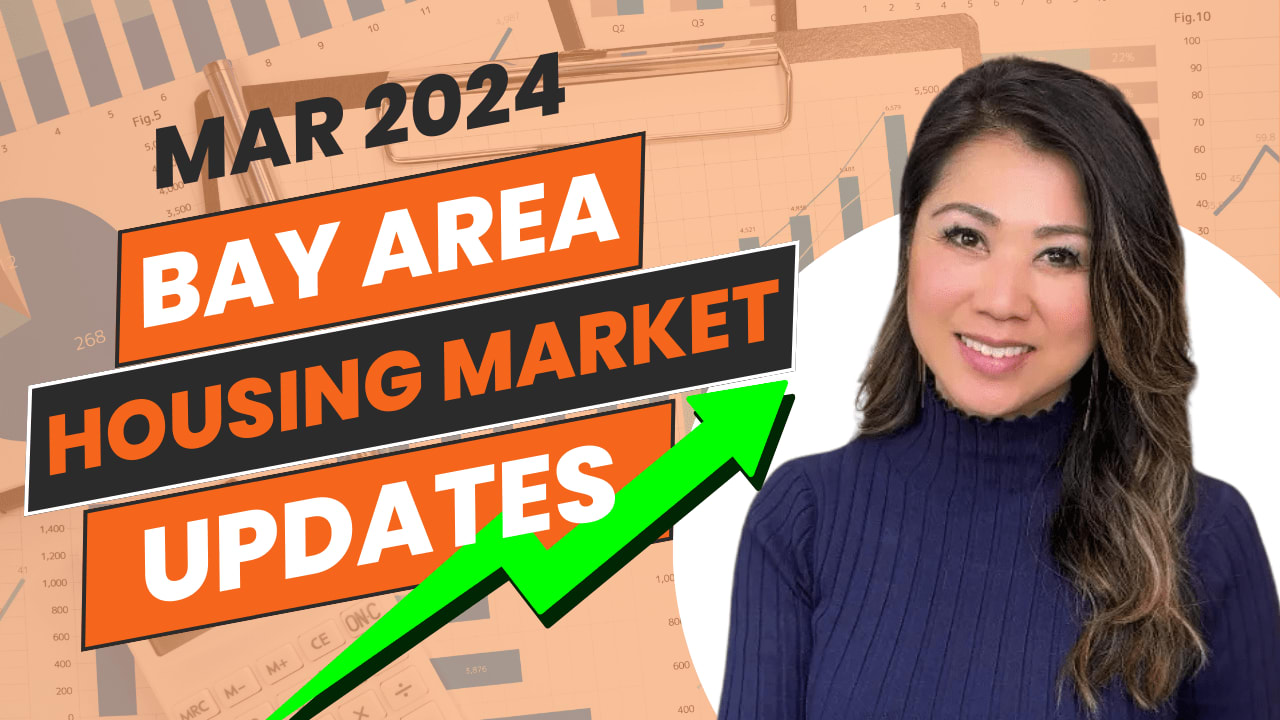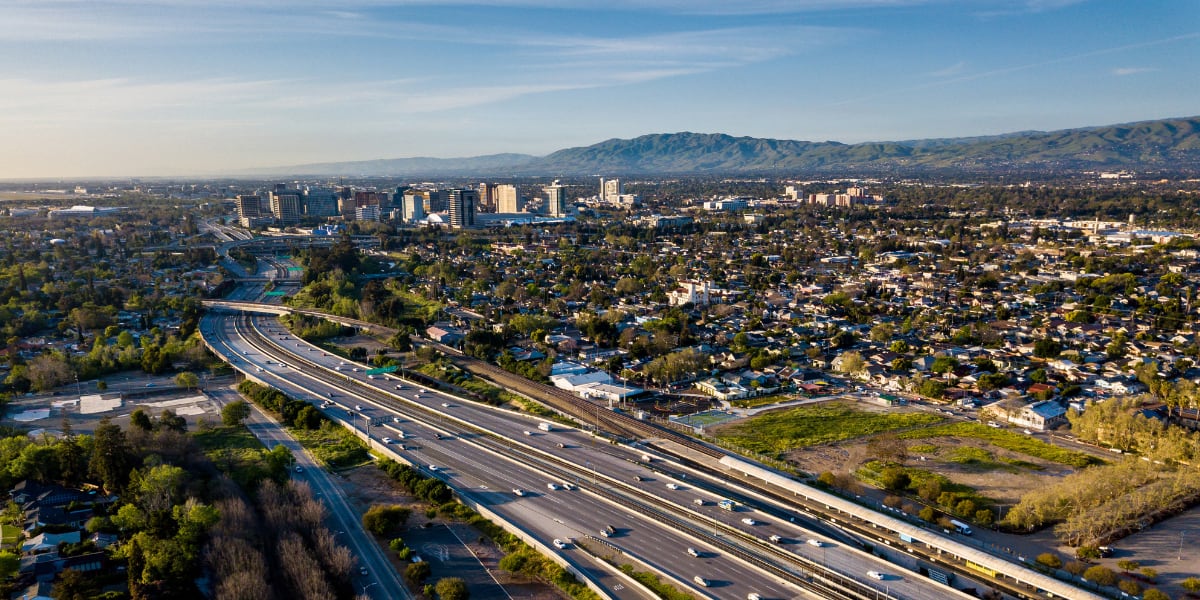I think this is a very interesting chart. You will see we've been tracking the median sales price for these five counties and Santa Clara County. For the pink highlighted numbers, that's the numbers that we saw the highest median sales price at the time. It was April 2022 for Santa Clara County at $1.95 million, San Mateo County at $2.25 million, and then Alameda County peaked in May 2022 at $1.5 million. San Francisco at $2.05 million in April 2022, and Contra Costa at $980,000 in May of 2022. But, so we know that the markets are slowing down. Just kind of going back to 2022 around May, I remember we had homes that we needed to put it on the market. We literally just shut off, no one came no matter how low you put the listing price at, people just didn't come out. So the pricing started to come down. We started seeing a lot of listings being withdrawn and then it kind of went down all the way to, for Santa Clara County, it's like December 2022 down to $1.465 million. That from peak to bottom, that was about 25% down, or dropped in terms of the price. And then for San Mateo County, went from $2.25M and dropped to the bottom at $1.48M in January 2023, and that was 34% dropped in terms of median sales price. Now Alameda County $1.5M to $1.022M that was about 32% dropped, and then San Francisco down to $1.385M that's another 32% drop and the Contra Costa went from $980K to $725K that was 26% drop. So when people ask me if we had bottomed out or if are we going to crash again, I can tell you that we had already crashed because it had dropped about 25% to as much as 35% for these counties. But now if you compare what we have like our median sales price now in March of 2024 now we have already come back from $1.465M to $1.87M. San Mateo County to $2M. Alameda County from $1M to $1.4M. San Francisco County went from $1.385M to $1.747M. Contra Costa County went from $725,000 to $905,000. It means that in the last year around just from one year ago our pricing actually had gone up almost 12% for Santa Clara County, and then also 12% for San Mateo County, 16% from Alameda County, San Francisco County is 3%, and Contra Costa County at 10.37%. So it's a pretty great numbers, although we haven't hit the previous peak yet. But considering our interest rate didn't drop back down to 2022 levels, which was in the four percent, and now we are still talking about high six, seven percent. But our pricing has already gone up very close to the previous peak, and I thought this is absolutely. It's like a lot of people were just very surprised, no one really expected that even despite these high interest rate. But that kind of reminded us is that buyers, homebuyers, they tend to forget or the first-time homebuyers who have not been on the market yet, they just find this is just normal now. You are expecting at six percent or, you know, close to seven percent interest rate and they're just going to make whatever works. And also because people haven't been really moving, moving in the past year or so, they saved up all these down payment and we do see a lot of people putting more than 20% down when they're making offers in our areas.

Now, this is the battleground that I was trying to show you guys. I'm trying to pick a few properties from different regions. For example, in Belmont, the two-bedroom one-bathroom house, and asking price was 1.4 million dollars. I had nine offers and went over 1.6 million dollars. Palo Alto, I thought this one is very interesting. It's the three-bedroom one-bathroom right next to expressway, so really loud, a lot of noise. It's only three-one, barely about a thousand square feet, asking $2.148M. Received six offers then sold around $2.7M. And here are some that in Cambrian has been very, very popular right now. These are some examples we show. It's like this is what we talked about, three hours on the market, they received an offer, it was already $400,000 above asking price and the seller just took it. And then here's a fixer, $1.6M. They received only two hours went to $1.8M. I didn't include here, but then I can tell you from our personal experience right now we also have single-family home in Cambrian asking price, I think it was around $1.7M. They received 33 offers and went to about 2.4 million dollars. That's the kind of numbers and competition. I know it gets very frustrating for some of the buyers. They really want to buy because we all know that you can actually finance later to lower your mortgage payment. So that's why we see a lot of competition on the market currently.

I thought to also share with you why is it that in Silicon Valley the real estate appreciates so quickly, especially compared to many other parts of the country. People always say that our area is just unlike anywhere else in the country. So when you listen to the news talking about the national real estate news, you have to really remember how Silicon Valley is a little bit different or the Bay Area in general is a little bit different. I thought this is very interesting. It is a study that was done back in 2021. But here you go. It says that the total real property values in Santa Clara County for single families is total about 338 billion dollars around 2020 to 2021. And actually, approximately 182 billion dollars' worth of properties have mortgages. That means the household real estate equity is actually at about 232 billion dollars. So, 69% of those actually have equity in it. And then out of that, the residents also hold approximately 453 billion dollars in investable assets. So, it could be stocks, it could be other properties. And combined, this total of 685 billion dollars in wealth. This is more than the GDP of Sweden and 155 other countries around the world. And when I read this research, and maybe if you guys would like to get a copy or you want the link, feel free to let me know. But I thought this is something that I was like, this is why we kept saying that Silicon Valley real estate is so different. And the people who are purchasing properties here, they have so much wealth. And because of that, we do have a very, very strong economy in Silicon Valley.

Of course, we all want to know about the mortgage projections, so we ask or we go look at Fannie Mae, Mortgage Bankers Association, and National Association of Realtors to see what they think the mortgage rate is going to be. But understanding that we have these parentheses, meaning that these are the numbers that change from their previous projections. So, regardless of what their projections are, you can see the trend is that this is going to continue to come down. And they do expect that in 2024, 4Q is probably going to come down to below 6% or right around 6%. So, I think this is a really great sign for a lot of buyers. However, it also means that we're going to see a lot more competition. Now, if you're asking me, does it mean that the market is going to go crazy for the rest of the year? I do think that there are other factors that can affect the market. One is that elections are coming up at the end of the year. So, typically, right before elections, people don't like that uncertainty. It doesn't matter who is going to win, they just don't like the fact that there's uncertainty. So, over and over again, right before elections, we usually see a slowdown in the market. So, if you are looking to buy and you're really frustrated with the competition right now, I would probably say that by the end of the year, you will see less competition. However, if you wait until then, the prices have already gone up quite a bit. So, I do encourage that if you're able to get into the market right now, definitely try to do so.

I'm just going to share one thing about the commercial real estate market because I know a lot of people are going to ask about it. Is there going to be a lot of distressed sales? And I think this is like people keep waiting and waiting. It's like, okay, when are the foreclosures going to come on the market? And unfortunately, it doesn't look like we're going to see a lot of foreclosures. Even here is that from Marcus & Millichap, it says the multifamily delinquency is still well below expectations. In 2011, we had about a 16.9 percent delinquency rate. Right now, we're only seeing a 2.6 percent delinquency rate. So, why, how, how come, why are these multifamily or these commercial real estate, when their loans supposed to do and then they have adjustable rate? Why aren't they going delinquent or foreclosure? And one of the main reasons is that the lenders understand this and that they go in and restructure their loan for them. So, that's to prevent these property owners from going into foreclosures. So, this is one of the reasons why we actually see very low delinquency rates. So right now, unlike the previous projections by a lot of people and the economists, we, besides office buildings, all the other commercial real estate asset types, we don't see a lot of overwhelming delinquency that we were expecting.

One more thing about this is that we also see, especially for the multifamily side, an increase in housing demand. We have to understand that people always talk about, well, we have a lot of layoffs in the Silicon Valley area, tech layoffs. That's all we hear. So, if you look at the chart here, a lot of these tech companies actually increased their headcounts drastically around 2020 and 2021. As an example, Amazon went from 750,000 employees in 2019 to 1.5 million employees in 2021. And then, so far, they laid off about 27,000 employees. So, it's really a very small number compared to how many they have added. And it's kind of the same across the board. So, you'll see that they did do some layoffs, but compared to 2019, we still have quite a few employment available. And on top of that, the stocks: Nvidia, they tripled their stock just in 2023 from 225 to 925, or maybe more than tripled almost. And then, Meta is 173 to 495, and Apple went from 145 to 170 dollars, and Google went from 90 to 151 dollars. For all those people who did not purchase properties in 2023, they're just gaining these stock values. And this is also one of the reasons why we see a lot of people coming onto the market to purchase and putting so much down payment and driving up the house housing prices. So, I hope this information is valuable for you.

Now, I definitely want to talk about ADUs. Before I introduce you to the speakers, here's another statistic that I want to share with you. I pulled all the sold listings since January of 2024 for single-family homes in Santa Clara County. There are 548 sold listings for homes without any additional structure. There are only 15 homes that have an additional structure, but they are smaller than 500 square feet. And then, there are another 15 homes that have an additional structure that are larger than 500 square feet. I'm surprised, but not surprised, how few properties actually have ADUs or additional structures on them. So, now let's get into the ADU conversation.
During our March Townhall, we also engaged in an insightful discussion with industry experts regarding the recent California bill AB1033, which grants homeowners the opportunity to sell ADUs separately. If you couldn't attend the webinar, fret not! The recording will soon be available on our YouTube Channel. Be sure to subscribe and enable notifications to stay updated!









